
Upcoming Webinar: Regional Perspectives on mCDR along the U.S. West Coast, Alaska, and British Columbia
This webinar will provide a regional overview of marine carbon dioxide removal (mCDR) activities along the North American Pacific Coast.
Research Area
Ocean acidification impacts the survival and growth of marine life that we rely on. Research on the biological response to ocean acidification focuses on economically, ecologically, and culturally important marine species. We can use what we learn about species’ physiology and sensitivity to acidification to anticipate how aquaculture, wild fisheries and food webs may be affected by changing ocean chemistry.
NOAA’s Ocean Acidification Program supports research that examines how marine life and ecosystems respond to ocean acidification so we can better protect and manage our marine, coastal and Great Lakes resources. NOAA is mandated by the Federal Ocean Acidification Research and Monitoring Act of 2009 to advance understanding of ocean acidification and its biological impacts on marine organisms and marine ecosystems.
Our communities and economies rely on marine biology – from the tiniest marine organisms to global coral reefs – for food security, jobs, recreation and cultural ways of life.
It is critical that we understand how changing ocean conditions may impact commercially important species in order to manage aquaculture and wild fisheries. Equally important is anticipating how ocean acidification may affect ecologically significant species, disrupt the food web, and cause ripple effects throughout ecosystems we depend on.

Explore your local marine economy using NOAA’s ENOW Explorer. Select your state or county to learn about tourism, jobs, and the monetary value of the marine, coastal, and Great Lakes resources where you live.
Researchers study biological sensitivity to ocean acidification in the laboratory and in the ocean. Controlled laboratory experiments allow scientists to test isolated variables, observing the biological response to one change in ocean chemistry at a time. Observations from ships, uncrewed platforms, and satellites provide real-world data about marine species and the chemical conditions they are living in.
Controlled experiments allow scientists to vary ocean conditions one variable at a time to determine the biological sensitivity to ocean acidification and identify which of the carbonate chemistry parameters (pH, saturation state, partial pressure of carbon dioxide, dissolved inorganic carbon, and alkalinity) drive the response. In the lab, researchers can study behavioral and physiological changes across different life stages of economically and ecologically important species. The results inform scientists and fisheries managers about species sensitivity and populations of concern.

A primary advantage of our research cruises is that we collect paired biological and chemical observations along the U.S.’s major coastlines. These data allow scientists to explore how marine biology is changing, and how those biological changes may be linked to shifting ocean chemistry. Our Coastal Ocean Acidification Research Cruises sail on a four-year cycle for each coastline, allowing us to track long-term biological response. We also support cruises through NOAA’s Northeast Fisheries Science Center Ecosystem Monitoring (EcoMon) program and the National Coral Reef Monitoring Program (NCRMP).

Scientists collect water samples to measure the amount of microscopic living plant matter (phytoplankton) in the water. Phytoplankton are the foundation of the marine food web.

Nets towed through the water collect zooplankton, tiny marine animals, to determine the total biomass, abundance, and types of zooplankton species present. Zooplankton graze on phytoplankton and are eaten by larger marine animals – another key link in the food web.

Certain types of plankton, like pteropods, are indicator species for ocean acidification. Indicator species are especially sensitive to ocean acidification and changes in their abundance or condition may be an early warning sign of biological sensitivity. For example, dissolution of pteropod shells is a signal that the ocean is growing more acidic.
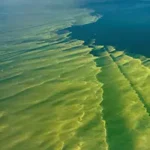
Some plankton species produce toxins that can be harmful when large blooms of these microscopic plants occur. Harmful algae blooms (HABs) may occur more frequently due to ocean acidification. Monitoring HAB species helps us understand how ocean acidification and HABs are linked.
Surface vehicles, profiling floats, and moorings deployed in the ocean can measure biological variables along with ocean chemistry, providing data more frequently than research cruises and with greater geographic coverage. Collecting long-term chemical data with an uncrewed platform also provides important environmental context for biological field research conducted in the same location.
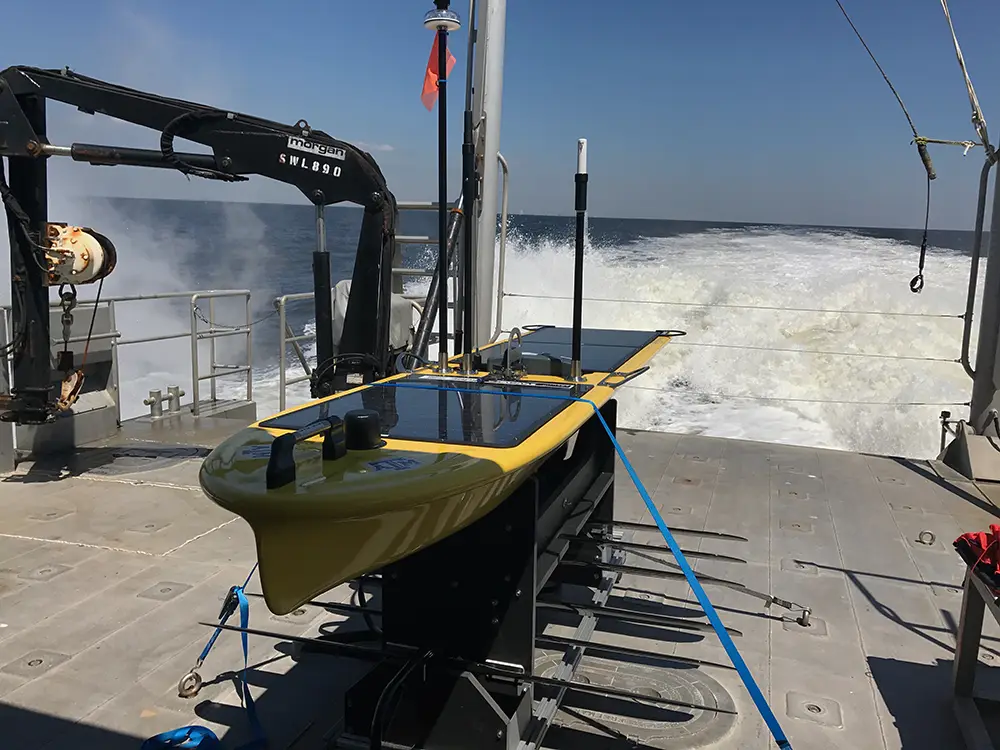
Satellite data can provide a global snapshot of the surface ocean, including biological patterns like phytoplankton growth which is detected based on the color of the ocean. Satellite observations must be ground-truthed with direct measurements of the ocean. Scientists on our research cruises put instruments into the ocean to collect on-the-ground data as satellites pass over, helping develop the potential of remote sensing for ocean acidification research.

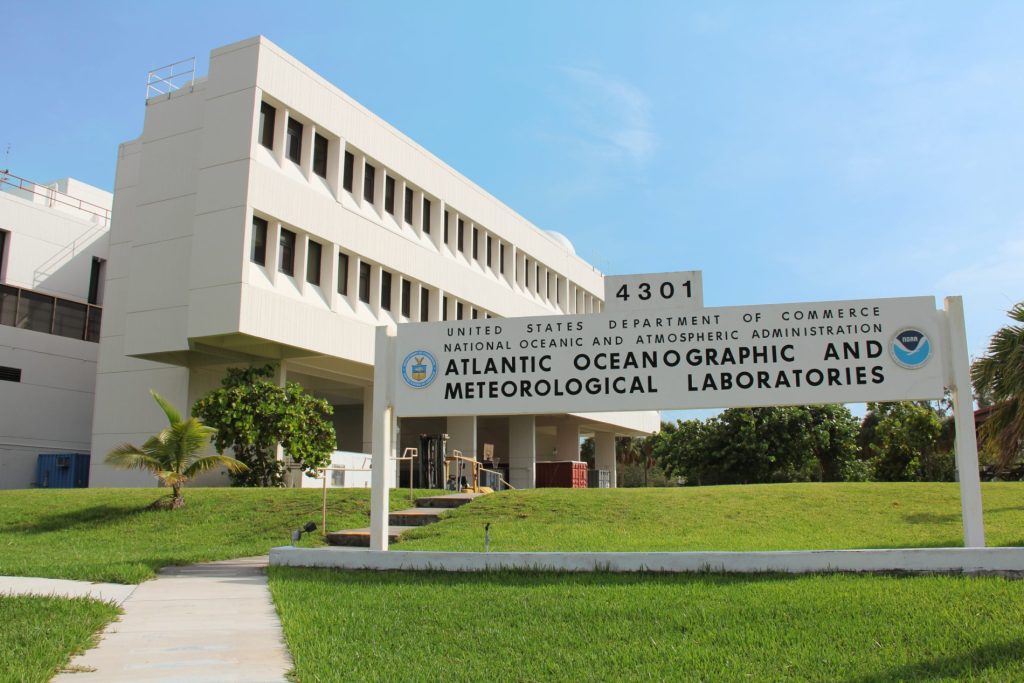
Research Laboratories Studying Biological Response
NOAA national laboratories are global leaders for delivering innovative strategies for ocean observations and support tools for managing marine resources.
NOAA’s Pacific Marine Environmental Laboratory (PMEL) makes critical observations and conducts groundbreaking research to advance our knowledge of the global ocean and its interactions with the earth, atmosphere, ecosystems, and climate. This includes research, observations, and technology development in support of society’s response to urgent challenges with ocean acidification and ocean change.
NOAA’s Atlantic Oceanographic and Meteorological Laboratory (AOML) conducts world-class Earth system research, with a focus on the Atlantic Ocean region, to inform: the accurate forecasting of extreme weather and ocean phenomena, the management of marine resources, and an understanding of climate change and associated impacts. AOML improves ocean and weather services including advancing our understanding of ocean and coastal acidification and its potential impacts on coral reefs and other ecosystems.
Fisheries Science Centers Studying Biological Response
NOAA National Marine Fisheries Service Science Centers have state-of-the-art experimental facilities to study the response of marine life to the chemistry conditions expected with ocean acidification.
The Northeast Fisheries Science Center has facilities at its Sandy Hook, NJ and Milford, CT laboratories; the Alaska Fisheries Science Centers at its Newport, OR and Kodiak, AK laboratories; and the Northwest Fisheries Science Center at its Mukilteo and Manchester, WA laboratories. All facilities can tightly control carbon dioxide and temperature. The Northwest Fisheries Science Center can also control oxygen, and can create variable treatment conditions for carbon dioxide, temperature, and oxygen. At the Pacific Islands Fisheries Science Center, coral research connects ocean conditions with reef health. These facilities include equipment for seawater carbon chemistry analysis, and all use standard operating procedures for analyzing carbonate chemistry to identify the treatment conditions used in experiments.
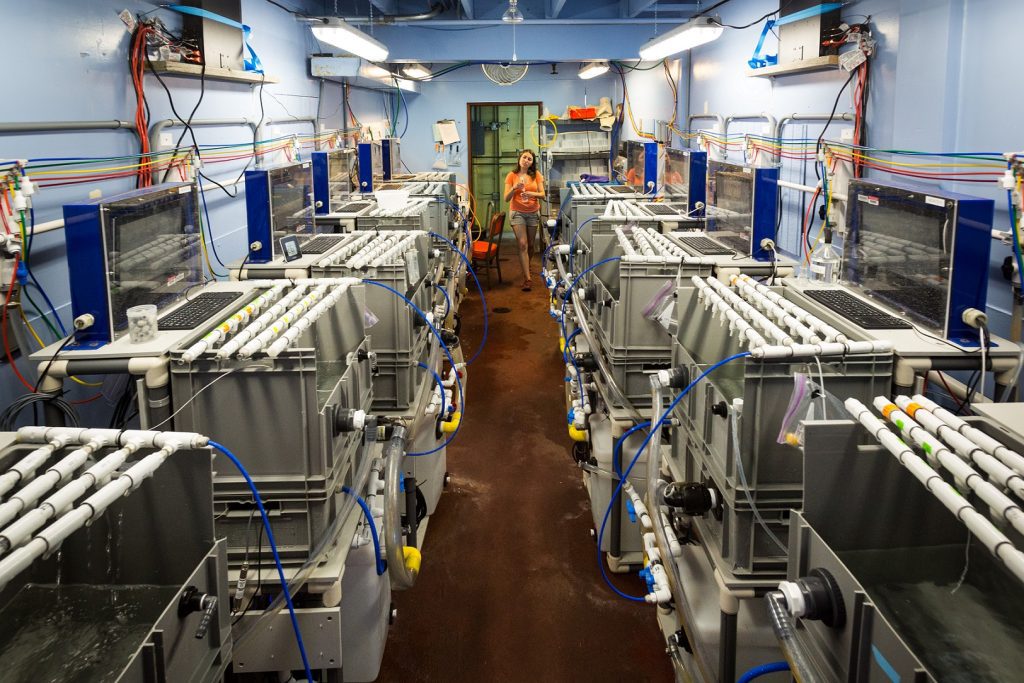
Marine species experience a range of biological responses to ocean acidification. Some species are directly impacted, like those whose calcium carbonate shells and skeletons are constructed using carbonate ions as building blocks. As ocean acidification increases, carbonate ions become less abundant in seawater and it becomes harder for species to build and maintain their calcium carbonate body parts. Other species may experience indirect impacts that alter their sensory systems, growth, or predator-prey relationships. All impacts can have cascading effects through individual species, ecosystems, and food webs.
Ocean acidification can have a variety of indirect impacts on fish, including altering behavior, otolith (a fish’s ear bone) formation, and young fishes’ growth.
Ocean acidification makes it harder for shellfish to build and maintain their calcium carbonate shells, impacting their growth and survival.
Coral reef growth is limited by ocean acidification conditions, which weakens and hinders construction of calcium carbonate coral skeletons.
Some tiny marine plants and animals have calcium carbonate structures that are vulnerable to dissolution under ocean acidification conditions.
See our funded projects in biological response.
Use the Projects Portal to search.

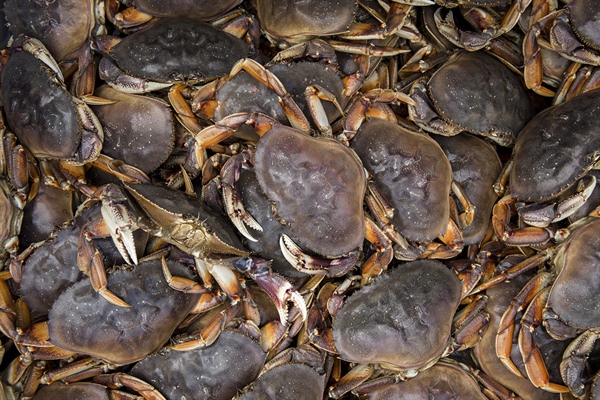

See publications from our funded projects for biological response
See our most recent news related to biological response.

This webinar will provide a regional overview of marine carbon dioxide removal (mCDR) activities along the North American Pacific Coast.

This story was originally posted on the MARACOOS website. Chesapeake Bay anglers use CBEFS forecasts to track low-oxygen zones, harmful algal blooms, and other conditions for safer, more productive fishing. OAP supports this forecasting tool that gets ocean chemistry information into the hands of anglers and others. For anglers on the Chesapeake Bay, few things

A new technical report published by the Fisheries and Ocean Canada and NOAA summarizes our knowledge gaps regarding the potential of blue carbon to mitigate coastal ocean acidification in shared waters.
The NOAA Ocean Acidification Program exists to meet the ocean acidification research and monitoring needs of the U.S. See how you can get involved to serve your community and participate in cutting-edge research and education and outreach.

Bioeconomic models are a multidisciplinary tool that use oceanography, fisheries science and social science to assess socioeconomic impacts. Funded by the Ocean Acidification Program, researchers at the Alaska Fisheries Science Center use a bioeconomic model to study the impacts of ocean acidification on Eastern Bering Sea crab, northern rock sole and Alaska cod. The goal is to predict how ocean acidification will affect abundance yields and income generated by the fisheries. This work informs the potential economic impacts of ocean acidification and future decision making and research planning.

Long-term declines of red king crab in Bristol Bay, Alaska may be partially attributed to ocean acidification conditions. These impacts may be partially responsible for the fishery closures during the 2021–2022 and 2022–2023 seasons. Researchers found that ocean acidification negatively impacts Alaskan crabs generally by changing physiological processes, decreasing growth, increasing death rates and reducing shell thickness. Funded by the Ocean Acidification Program, scientists at the Alaska Fisheries Science Center continue to investigate the responses of early life history stages and study the potential of various Alaska crabs to acclimate to changing conditions. Results will inform models that will use the parameters studied to predict the effects of future ocean acidification on the populations of red king crab in Bristol Bay as well as on the fisheries that depend on them. Fishery managers will better be able to anticipate and manage stocks if changing ocean chemistry affects stock productivity and thus the maximum sustainable yield.

Understanding seasonal changes in ocean acidification in Alaskan waters and the potential impacts to the multi-billion-dollar fishery sector is a main priority. Through work funded by NOAA’s Ocean Acidification Program, the Pacific Marine Environmental Laboratory developed a model capable of depicting past ocean chemistry conditions for the Bering Sea and is now testing the ability of this model to forecast future conditions. This model is being used to develop an ocean acidification indicator provided to fisheries managers in the annual NOAA Eastern Bering Sea Ecosystem Status Report.
The NOAA Ocean Acidification Program (OAP) works to prepare society to adapt to the consequences of ocean acidification and conserve marine ecosystems as acidification occurs. Learn more about the human connections and adaptation strategies from these efforts.
Adaptation approaches fostered by the OAP include:

Using models and research to understand the sensitivity of organisms and ecosystems to ocean acidification to make predictions about the future, allowing communities and industries to prepare

Using these models and predictions as tools to facilitate management strategies that will protect marine resources and communities from future changes

Developing innovative tools to help monitor ocean acidification and mitigate changing ocean chemistry locally
Drive fuel-efficient vehicles or choose public transportation. Choose your bike or walk! Don't sit idle for more than 30 seconds. Keep your tires properly inflated.
Eat local- this helps cut down on production and transport! Reduce your meat and dairy. Compost to avoid food waste ending up in the landfill
Make energy-efficient choices for your appliances and lighting. Heat and cool efficiently! Change your air filters and program your thermostat, seal and insulate your home, and support clean energy sources
Reduce your use of fertilizers, Improve sewage treatment and run off, and Protect and restore coastal habitats
You've taken the first step to learn more about ocean acidification - why not spread this knowledge to your community?
Every community has their unique culture, economy and ecology and what’s at stake from ocean acidification may be different depending on where you live. As a community member, you can take a larger role in educating the public about ocean acidification. Creating awareness is the first step to taking action. As communities gain traction, neighboring regions that share marine resources can build larger coalitions to address ocean acidification. Here are some ideas to get started: